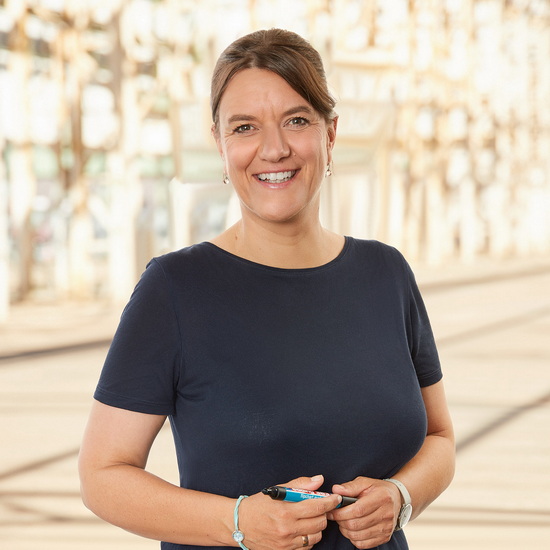Agile methods in comparison: Design Thinking, Design Sprint, Lean Startup, Scrum, Business Model Canvas. How do they work? Where are they used?
Agile methods at a glance:
Design Thinking, Design Sprint, Lean Startup, Scrum, Business Model Canvas
In this article, we take a closer look at various agile methods: Which agile method can be used for which purpose? What distinguishes each method? What is comparable? Where are the differences? How do agile processes work?
We have opted for the following best-known agile methods: Design Thinking, Design Sprint, Lean Start Up, Scrum and Business Model Canvas.
We will then go into each method in detail in future articles.
In the context of agile transformations, as we, the berliner team, support many clients, it is firstly about the attitude with which people approach issues, i.e. the corporate culture. On the other hand, it is also about concrete methods that help companies to act faster and in a more customer-oriented way.
In our article Agile product development: What is it and how does it work, we looked at the 6 basics of agile methods, i.e. what agile methods are and what agile product development is good for.
Agile methods: The possible applications
If you take a look at our diagram, you will see that the agile methods we have described are used at different points in the course of product development. This means that they can tackle different challenges with each method.

Design Thinking
The beginning of product development: If you have a rough idea for a possible product or if you don’t yet know where the journey will take you – i.e. what you could develop next – then design thinking will be a great help. Here you go through a generic, broad process in the course of which you generate – and discard – many ideas. Here you are open to everything and are looking for a new direction, the result here is: an idea for a product or service. The process can take days or even months.
Design Sprint
The design sprint is much more concrete: if you already have a product idea, a design sprint helps you to develop the idea into a concrete product, initially into a prototype. For example, if you asked yourself during a design thinking process “What could our new products be? What can we inspire the market with?”, then one possible result could be We develop an app. Using the design sprint method, you work on how the app could look in concrete terms so that it fulfills the customer benefit in the best possible way. At the end of this process, there would be a prototype.
Lean Startup
Like Design Thinking, Lean Startup is both a basic attitude and a method. The Lean Startup method helps you to find out how you can test this prototype or the product that you may have developed with Design Sprint. It is important to find out what the customer really wants and to develop the best business model for this. And nobody knows this better than the customer himself.
Scrum
You already know your product, have a business model – and now you want to get started: for example, you want to develop the product. Scrum can help you with this: how do you set up agile project management so that teams can work together optimally and achieve good results quickly and in a customer-oriented manner? Which work packages, which processes do you initialize? Who does which to-dos and when? And what options are there for involving customers in the development process and getting feedback from them? The Scrum process also involves constant testing of what works, what doesn’t and what is received by the customer – and then production is constantly readjusted. Working with Scrum does not always have to be about a product. Today, Scrum can be used in many projects, not just in software development.
Business Model Canvas
If you want to sell a finished product or service, the Business Model Canvas is a good tool. The question here: What does the business plan and the business model look like? In this context, various questions help to make the idea more concrete and to think through the business model. Of course, it makes sense to work out your business model in parallel with the production process.
Articles on agility and agile methods
If you are interested in reading more about this topic, take a look at the following articles:
Agility: Our company is becoming agile – where do we start?
Agile methods
Agile methods – an overview
Now let’s take a closer look at the individual agile methods:
Design Thinking
Design thinking is one of the best-known agile methods. Generating ideas with design thinking is a series of several process steps. What it is not is a linear, concrete, predetermined process that can be completed in two days. There are certainly many companies that try to do this anyway: “We’re doing design thinking and are agile from now on.” Unfortunately, it doesn’t work that way, because design thinking is more of a basic attitude, a way of thinking. Design thinking is characterized by a great openness to feedback, ideas, different opinions – and diversity. The more diverse a team is, the more different the perspectives are, which enriches the process – and ultimately the result.
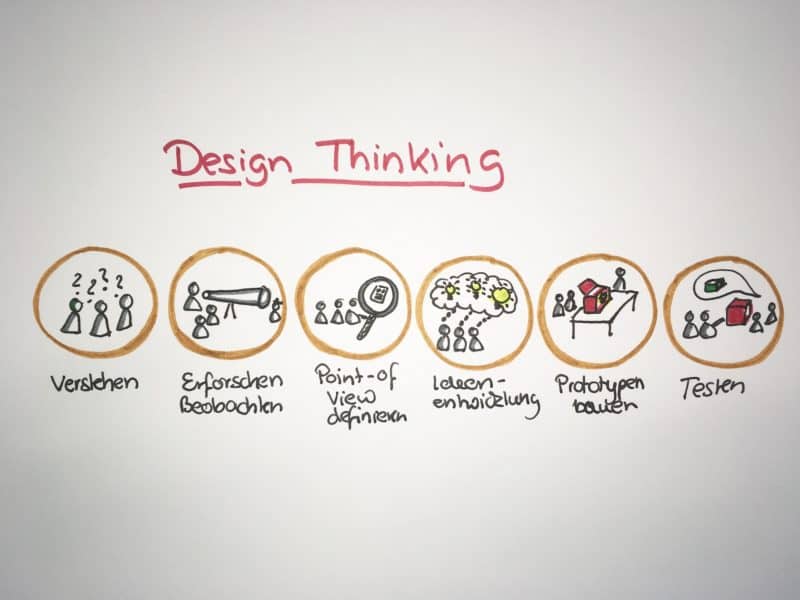
Phase 1: Understanding the problem
The first phase of Design Thinking begins with the basic attitude: “I know that I know nothing”.
You and your team develop an assumption about a problem or a hypothesis about a possible product – i.e. a question for which you want to find a solution in the course of the process:
- What is it about?
- For whom is this useful?
- What are the framework conditions?
- What condition should be created?
Their aim is to develop a common understanding of the problem. This gives you and your team direction for your research.
You know that you have no idea about your potential product at the moment, but your head is all the more filled with prejudices and assumptions. Your first task is to throw these assumptions overboard. At this point, it is your intention to start with an open mind – figuratively speaking, with a blank, virgin sheet of paper, i.e. from scratch.
Phase 2: Observe / Research / Explore
With the hypothesis/question and your open mind, you enter the world of your customer, the situation in general, the market situation – and start by gathering all the information you can.
What could that be? You can research what other companies are doing, listen to inspiring presentations, ask customers, stakeholders, partners, suppliers or other people about the topic. There are special forms of questioning that are very open and that find out as much as possible about the habitus of the interviewee instead of putting something in their mouth.
The customer is also observed in everyday life. How does he behave? How often does he use tools, websites and so on that are relevant to the problem?
Your task is to collect everything related to the suspected problem or possible product.
Phase 3: Define theses/point of view
In the next step, the knowledge gained is compiled so that the team has the same level of knowledge. Theses are then formulated in order to develop a deeper understanding of the customer and the problem to be solved. A wide variety of tools and techniques are available here.
The persona
Here we present the persona as an example: In order to be able to empathize with the customer, their wishes and needs, a persona is often created in this phase. This is as detailed and specific a description of a potential customer as possible. It is not about a target group for example: “Our target group is 30-year-old academics.” A persona describes a single person from this target group. Our 30-year-old academic could be called Max, he graduated in electrical engineering in Giessen, is married and has two children. They are called Lisa and Edward and are one and three years old. He lives in a rented detached house, his wife Lena, 32….. By thinking and feeling your way into the customer’s shoes and understanding the customer’s actual needs, concerns and wishes, you get closer to what the problem to be solved really is. It is often at this stage that you realize that the original hypothesis you started with – i.e. the original idea of what the customer might need – has to be thrown overboard and something completely different has to be created. The most important question is: are you solving your customer’s actual problem?
Phase 4: Finding ideas
Now that the task has been discussed in the first three phases, the process of finding a solution begins. Using tools such as brainstorming, as many ideas as possible are generated, many are dropped and some are selected.
Phase 5: Prototypes
The next step is to build a prototype. This should be as simple as possible to produce – and of course inexpensive. The prototype should give the customer a look and feel, i.e. an impression of the potential product. If the customer can experience the future product in this way, they can give you feedback that you can use as a basis for further development. If you are developing software, for example, it is relatively easy to present a prototype: A PowerPoint presentation in which the customer can click on individual features might be sufficient. For other ideas, it can be more difficult to find a suitable prototype. For example, one client had the idea of setting up a special coworking space – but how do you create a prototype for a coworking space? Creativity is required here. Ultimately, it is important to allow the intended visitor to the space to experience the idea in order to find out what they need and want as a customer.
Phase 6: Test
You have gained insights from the prototype and the customer’s feedback. This allows you to go back into the development process, improve and adapt. It is not only the last two phases, i.e. the prototype submission and subsequent customization, that you will probably go through more often. With the design thinking method, you develop your product iteratively – i.e. step by step – and improve it.
Design Sprint
What is Design Sprint in comparison? Design Sprint was developed by Google. It contains methods from Design Thinking; however, it is a much more rigid concept in comparison: On the Design Sprint slide you can see – there is Monday, Tuesday, Wednesday and so on. The Design Sprint is designed for five days, whereas a Design Thinking process can take several months. The design sprint contains elements from various agile methods. The aim is to generate ideas quickly and to discard them again if necessary. Here too, the aim is to involve the customer in the process as much as possible and ultimately present them with a prototype.
In order to have a finished product at the end, i.e. after a maximum of five days, a very clear set of rules is used. For example, there are precise instructions as to what you do on which day. During the design sprint, it is also essential to adopt as many perspectives as possible, i.e. to pay attention to the wishes, needs and problems of all those involved. The design sprint is created by a group of around eight people.
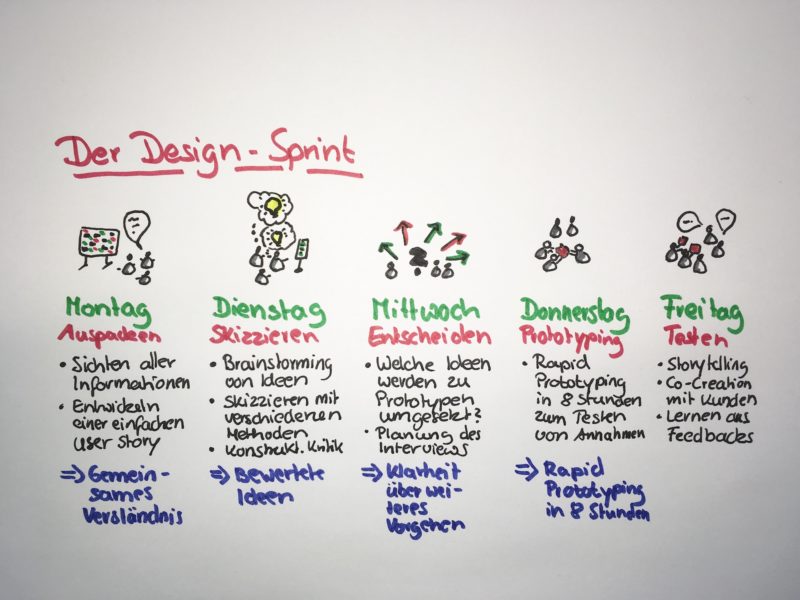
An example from our work with the Design Sprint:
Our customer was a bank. The aim was to develop an app that helps employees to prepare and settle their travel expenses for accounting more quickly and easily. This type of travel expense accounting saves the company a lot of time and work. The app was developed within a week by a group of eight people, including users from the company. After a week, the prototype was finished and tested.
Advantages of the Design Sprint:
That’s the beauty of the Design Sprint: you’re done with it on Friday. You don’t have to rework, you have a result. The creative process, i.e. the work that requires an exchange of ideas and the inclusion of many perspectives, is then complete. Of course, there is also the implementation work, such as programming and implementing the app, but this no longer requires the entire development team.
Design sprint in change management:
We also use the Design Sprint for agile organizational development in companies. In this way, the change process for agile organizational development can be designed together with all those involved, for example top management, HR managers, employees, middle management and so on. A prototype of the change process can be planned within five days. This is then made available to all employees as a communication concept. We have had very good experience with this because we have everyone on board in the design sprint: top management and the employees who are responsible for implementation. This means that employees do not have to wait for top management to make decisions or express opinions. Instead, they are put in a position to drive change forward independently and in full. This only takes five days. And it can be done even faster: we have already completed such a design sprint process in four days!
Lean Startup
Lean Startup is a relatively new method developed by Eric Ries. In 2011, he published his book “The Lean Startup: How Today’s Entrepreneurs Use Continious Innovation to Create Radically Successful Businesses” – and it changed a lot. Lean Startup is also not just a method, but an attitude, a way of thinking. This helps you to act innovatively, quickly and with the customer’s benefit in mind. Lean Startup was originally developed to help startups with little capital get on their feet. – This means making sure that the company does not waste money by producing things that nobody needs afterwards.
Fast testing
Lean Startup assumes that there is one good idea among ten that can also be used to make money. This is also the approach taken by investor Rocket Internet: Rocket Internet invests in ten companies, i.e. ten ideas, and hopes that one of them will generate a hundredfold return, as Zalando has done. This means that the investments in the other nine ideas have also paid off.
The basic principle is the same here: You bring something to market quickly and test whether it works. If it doesn’t work, drop it quickly and look for a new idea.
This method was originally aimed at people who wanted to found a start-up and did not yet have a business idea. However, conventional companies are now also making use of Lean Startup.
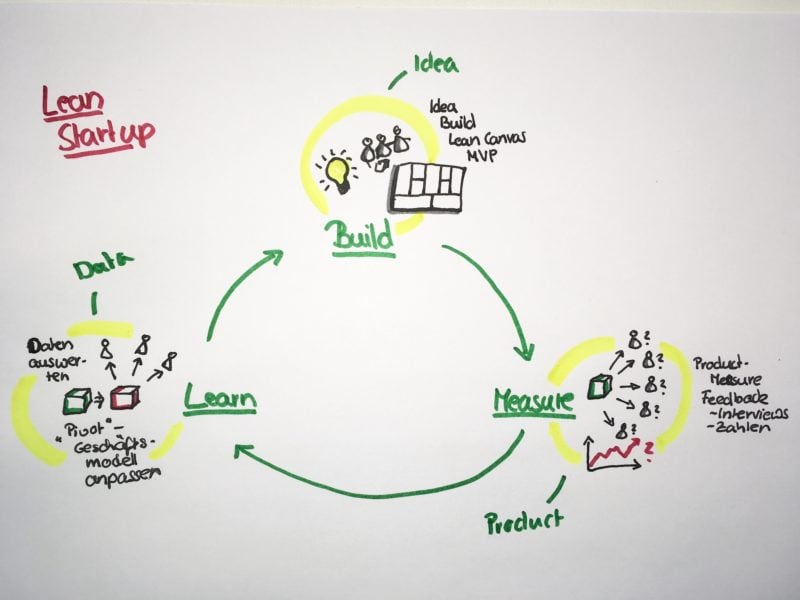
Basics of Lean Startup
Many of the basic principles can be found in other agile methods – above all the focus on customer benefit. Here are the key terms from Lean Start Up:
Build, Messure, Learn
- Build: You develop a product and bring it to market.
- Messure: You find out what the customer says.
- Learn: You learn from this: if the customer rejects the product, you take it off the market or you change it until it reaches the customer.
Pivot
Another term from Lean Startup is pivot. Pivot means “total, drastic rethinking of the business idea”. This means that the business idea is not simply modified, but that you should be prepared to change it fundamentally.
Very often, we experience that the founders of a start-up have difficulties changing their idea completely or even dropping it. Founders are often so in love with their idea that they add one feature after another to their product in the hope of making it suitable.
We are currently supporting a start-up that is developing an interesting new app. Here, too, function after function is programmed with zeal: a chat here, another page there and a little more blue there… Although it is great that they are so creative and the employees are bursting with ideas, development always takes much longer as a result, even though it has not yet been determined whether the basic idea is of any interest to the customer.
Minimal Viable Product
Creativity often has to be slowed down a little in order not to continue developing endlessly without feedback, but to first present a testable product – the minimal viable product. Here you need to ask yourself the question: What is the minimum/the most minimal version of your product that you need to make visible so that you can present something to the customer? What can you offer the customer to give them a feeling/impression of your product? This is the only way to get feedback from the customer.
Testing
Once you have presented the customer with a minimal viable product, the question arises as to how you can test and reliably measure what the customer wants and what they don’t want.
A food company could test whether its product is well received by customers by launching the product on the market in different regions in different packaging, for example – or in the same region in two different packs.
Another test option: A product is offered on the Internet that does not yet exist.
An example
Recently, an organic apple juice made from Polish fallen fruit was offered online. This was quite expensive. – The producer wanted to find out whether customers are prepared to dig deeper into their pockets for a high-end organic product. However, the customers were not: although many had looked at the product page, there were hardly any orders. So this project was scrapped and the apple juice was never produced.
In contrast to design thinking, where the customer is initially only asked what they want, something is offered for sale here; often something that does not yet exist or is not even ready yet. In the software sector, beta versions are sold at lower prices on condition that error messages are restored.
With our smartphones, it is already common practice to deliver an unfinished version and subject it to a test: the latest version of our operating system is usually still riddled with bugs – and yet it is already on the market. Without us realizing it, our phone sends information about this back to the company, which improves the software bit by bit with each update.
Scrum
Scrum originally comes from software development and has been used in completely different industries and areas for some time now; for example, we work with an HR department that is organized according to Scrum.
Against what background was Scrum developed?
Conventional product development – in software development and elsewhere – went as follows: A goal was set, work packages were distributed and then everyone worked on their own tasks.
The following problems frequently arose: When they met again after the scheduled work phase – after two months, for example – they often found that the employees had encountered challenges during development and had each solved them in their own way. However, as everyone had worked on their own, the different paths often no longer fitted together. Or: During the time that had elapsed during the development phase, new wishes and needs had arisen at the customer and the developed product was no longer compatible with the customer’s requirements. The task here was to find a method, an agile project management approach, that would solve these recurring problems.
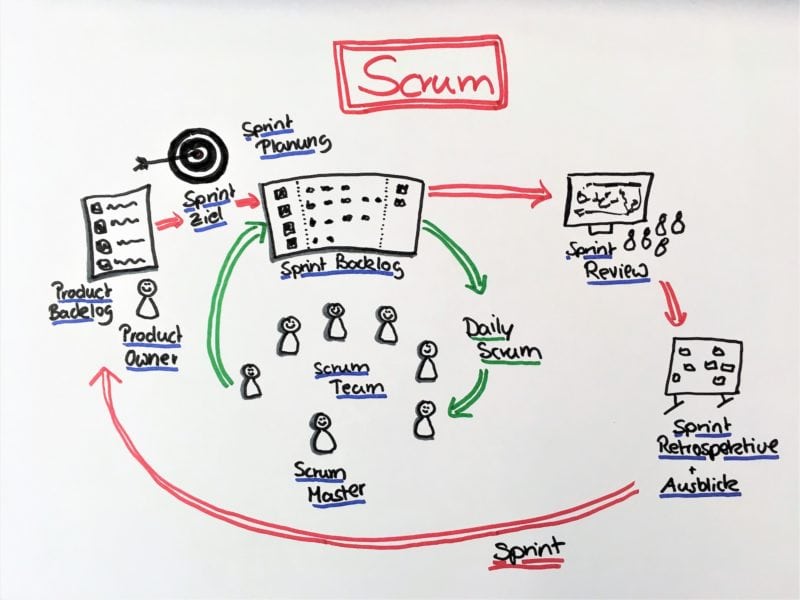
The 2 week interval
In view of the rapidly changing circumstances of our time, the question arose as to the period of time within which a feedback loop is necessary. I A scum interval lasts 14 days in most companies. During these two weeks, the team members work on their task packages, but meet frequently to exchange ideas. After the two weeks, the customer is consulted.
The Product Owner
One person is responsible for contact with the customer: the product owner. This can be an employee or even come from the customer. Its task is to verify the current status of product development with the customer. He obtains feedback from the customer and thus incorporates current customer needs and any new requirements into the development process. This means that at the beginning and end of each two-week interval, the product owner provides customer feedback on the basis of which the task packages for the next two weeks are put together.
Kanban Board
The team carefully estimates the volume of work it can actually accomplish in the two weeks. The upcoming tasks are displayed on a Kanban board and are therefore visible to everyone. Now the individual team members take on tasks, i.e. they signal to the others that they are taking on the respective task. When an employee has completed a task, they move on to the next one. The aim is, of course, to complete all tasks within two weeks.
The Scrum Master
Another important function in Scrum is the Scrum Master. His task is to ensure that the development process remains on track:
- He makes sure that the team regularly takes tasks from the Kanban board and that the tasks are well distributed.
- The Scrum Master convenes daily stand-up meetings in the team. In the morning, everyone reports on what they are currently working on and what their findings are so that the team can coordinate at the interfaces. The Scrum Master keeps these meetings short and to the point.
- He also ensures a weekly exchange.
- In the event of conflicts, he helps the team to resolve them.
Scrum Master and Product Owner
Although the Scrum Master ensures that the team receives regular feedback from the customer, they are only responsible for the development process and should never take on the tasks of the Product Owner. Some companies find it financially tempting to entrust the same person with the functions of Product Owner and Scrum Master – but the Product Owner represents the customer perspective and the Scrum Master organizes the team. Conflicts can arise here: it is hardly possible to represent the interests of the customer and at the same time keep an eye on the process and the challenges and circumstances within the team.
The Scrum Master has an overarching function: their task is to moderate the process neutrally and constructively between all sides. He ensures that the important process steps are adhered to and regularly asks the questions: Are we still on track? Has anything changed? How do we react to this?
This can also be done by someone outside the company.
Out of the linear routine business
Scrum only works if the team is fully involved in the process. We have already observed that employees in large companies have worked on other projects and organized the innovation process according to Scrum on the side, with about 10% of their working time: That doesn’t work! Innovation takes time and space and cannot be handled in parallel with routine, linear business operations. If a decision has to be made as to whether resources are allocated to linear business or innovation, urgency is always the deciding factor. As a result, day-to-day business usually wins and the innovative process falls by the wayside. So organize it differently! Get out of the linear routine business!
Links to Scrum
Business Model Canvas
Business Model Canvas is often mentioned in connection with agile methods. The method itself is not really agile, but it is a good addition to the agile methods already mentioned. The Business Model Canvas is well-known and popular; young, agile companies in particular like to work with it. That’s why we want to deal with it here.
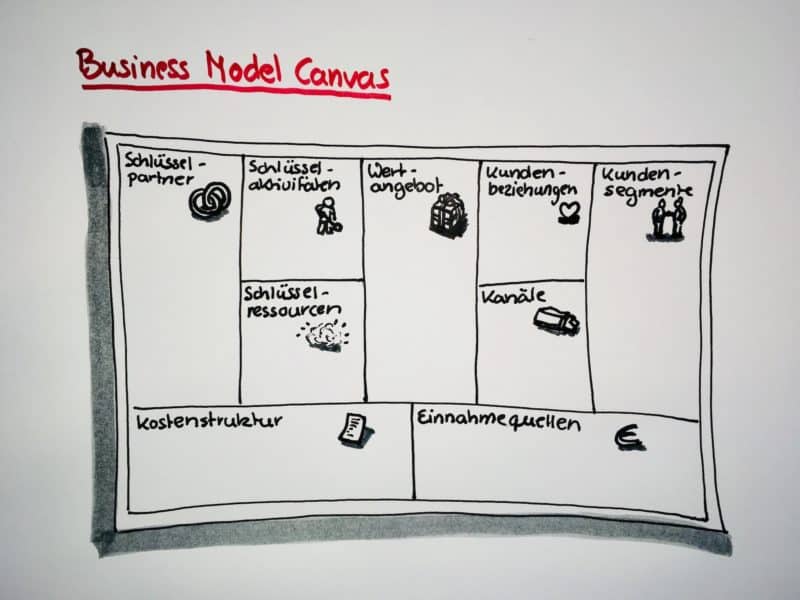
The classic business plan
You know how it is – a classic business plan is a work of many pages. All the details of a future business are listed here and the likely figures are calculated: Exactly how much will you earn in five years’ time? What do you want to have achieved by then? What exactly will your product cost? What expenses will you incur within these five years? And how much of your loans will you have paid off by then?
Business Model Canvas
The business model canvas also provides a structure to give a starter orientation for a new idea, but unlike the classic business plan, all of this fits on a single page. Here you can look at what your idea needs to get off the ground without having to draw up a five-year plan. The following nine areas are highlighted:
- Key partners
- Key resources
- Value proposition
- Customer relations
- Channels
- Customer segment
- Cost structure
- Sources of income
How do you earn money with the idea?
Let us take the question of sources of income as an example. A start-up that we are currently supporting is developing a new app. This should not cost the user any money at the beginning; it should be free to download. It will also not be able to generate any advertising in the initial phase. And so the question naturally arises: how can this generate revenue? Nowadays, this is no longer so clear-cut. In the past, most business models were structured quite simply: a product was sold and the customer paid for it. In the age of the Internet, these circumstances have changed – and with them, of course, the question of sources of income.
Advantages of the Business Model Canvas
The business model canvas also discusses what the network should look like, which sales channels are envisioned and what needs to be done to make it work at all. The business model canvas therefore also functions as a communication tool within the start-up team: it structures the idea and gives the team clarity and a shared vision. We have just moderated such a process and it turned out that although the team members were clear about many things, everyone in the management team had different answers to the respective questions. Through this process, the team has realigned itself together and clarified how it will proceed.
It can also happen that you run through the business model canvas with your finished product idea and unfortunately end up realizing that the costs and benefits are not in balance, that you cannot finance the project or that it would take too long for the project to make money. In contrast to a very elaborate and complex business plan, the Business Model Canvas provides you with clarity relatively quickly and easily as to whether your idea can be implemented or not.
Become active
Would you like to implement agile methods in your company? Get in touch with us!
Online collaboration
In pandemic times, we are all working with as little personal contact as possible: Video conferences and Zoom meetings are the order of the day. Design thinking, for example, is a great way to collaborate virtually: With an online meeting tool and online whiteboards. We’ve been doing this for a while now.
Many customers have asked us questions about this:
- How does Zoom work?
- What alternatives are there?
- Which ones are good and fit our requirements?
- How do we design online meetings that are fun instead of boring?
- How does the technology work? What do I need at all?
- Which online whiteboards are suitable for virtual collaboration?
- What tasks can we actually use online tools for?
We answer these questions – and many more – in detail in our article
Zoom Meeting & video conferencing: How it works, alternatives, tips
Articles on agility and agile methods
If you are interested in reading more about this topic, take a look at the following articles:
Agility: Our company is becoming agile – where do we start?










